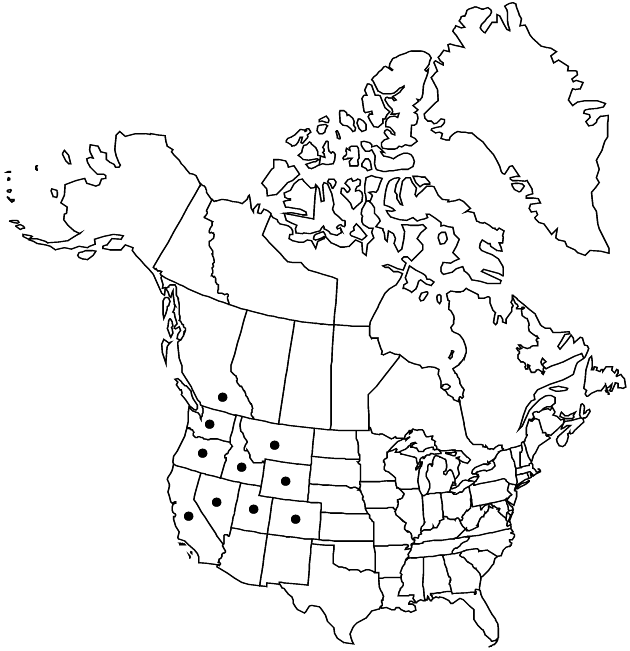Difference between revisions of "Crepis modocensis"
Erythea 3: 48. 1895.
FNA>Volume Importer |
RevisionBot (talk | contribs) m (Bot: Adding category Revised Since Print) |
||
| (8 intermediate revisions by 3 users not shown) | |||
| Line 8: | Line 8: | ||
}} | }} | ||
|common_names=Modoc or Siskiyou hawksbeard | |common_names=Modoc or Siskiyou hawksbeard | ||
| + | |special_status={{Treatment/ID/Special_status | ||
| + | |code=E | ||
| + | |label=Endemic | ||
| + | }} | ||
|basionyms= | |basionyms= | ||
|synonyms= | |synonyms= | ||
| Line 20: | Line 24: | ||
-->{{Treatment/Body | -->{{Treatment/Body | ||
| − | |distribution= | + | |distribution=B.C.;Calif.;Colo.;Idaho;Mont.;Nev.;Oreg.;Utah;Wash.;Wyo. |
|discussion=<p>Subspecies 4 (4 in the flora).</p><!-- | |discussion=<p>Subspecies 4 (4 in the flora).</p><!-- | ||
| − | --><p>Crepis modocensis is recognized by its tomentose or coarsely bristly stems and petioles, rosettes of deeply pinnately lobed leaves, rather large heads with relatively many phyllaries, and blackish cypselae.</p> | + | --><p><i>Crepis modocensis</i> is recognized by its tomentose or coarsely bristly stems and petioles, rosettes of deeply pinnately lobed leaves, rather large heads with relatively many phyllaries, and blackish cypselae.</p> |
|tables= | |tables= | ||
|references= | |references= | ||
| Line 61: | Line 65: | ||
-->{{#Taxon: | -->{{#Taxon: | ||
name=Crepis modocensis | name=Crepis modocensis | ||
| − | |||
|authority=Greene | |authority=Greene | ||
|rank=species | |rank=species | ||
| Line 68: | Line 71: | ||
|basionyms= | |basionyms= | ||
|family=Asteraceae | |family=Asteraceae | ||
| − | |distribution= | + | |distribution=B.C.;Calif.;Colo.;Idaho;Mont.;Nev.;Oreg.;Utah;Wash.;Wyo. |
|reference=None | |reference=None | ||
|publication title=Erythea | |publication title=Erythea | ||
|publication year=1895 | |publication year=1895 | ||
| − | |special status= | + | |special status=Endemic |
| − | |source xml=https:// | + | |source xml=https://bitbucket.org/aafc-mbb/fna-data-curation/src/2e0870ddd59836b60bcf96646a41e87ea5a5943a/coarse_grained_fna_xml/V19-20-21/V19_288.xml |
|tribe=Asteraceae tribe Cichorieae | |tribe=Asteraceae tribe Cichorieae | ||
|genus=Crepis | |genus=Crepis | ||
| Line 79: | Line 82: | ||
}}<!-- | }}<!-- | ||
| − | -->[[Category:Treatment]][[Category:Crepis]] | + | --> |
| + | |||
| + | [[Category:Treatment]] | ||
| + | [[Category:Crepis]] | ||
| + | [[Category:Revised Since Print]] | ||
Latest revision as of 19:22, 6 November 2020
Perennials, 5–35 cm (taproots slender, caudices branched). Stems 1–4, erect, slender to stout, simple or sparsely branched, glabrate to tomentose and bristly-setose. Leaves basal and cauline; petiolate; basal blades lanceolate, 7–25 × 2–4 cm, margins deeply pinnately lobed (lobes lanceolate, dentate, teeth mucronate), apices acuminate, faces tomentulose (at least when young). Heads 1–9, borne singly or 2–9 in cymiform arrays. Calyculi of 8–10, lanceolate, tomentose and often setose bractlets 2–4 mm. Involucres cylindric, 11–21 × 5–10 mm. Phyllaries 8–18, (medially green) lanceolate, 10–16 mm, (bases keeled, margins yellowish, often scarious), apices acute, abaxial faces often densely, blackish or whitish tomentose or setose, sometimes glabrous, adaxial with fine (shiny) hairs. Florets 10–60; corollas yellow, 13–22 mm. Cypselae blackish or greenish, reddish, reddish brown, or yellowish, subcylindric to fusiform, 7–12 mm, apices tapered or beaked (beaks 1–3 mm), ribs 10 (strong to weak); pappi dusky white, 5–13 mm. 2n = 22, 33, 44, 55, 66, 88.
Distribution

B.C., Calif., Colo., Idaho, Mont., Nev., Oreg., Utah, Wash., Wyo.
Discussion
Subspecies 4 (4 in the flora).
Crepis modocensis is recognized by its tomentose or coarsely bristly stems and petioles, rosettes of deeply pinnately lobed leaves, rather large heads with relatively many phyllaries, and blackish cypselae.
Selected References
None.
Lower Taxa
Key
| 1 | Setae of stems and petioles yellowish, ± straight, (those of phyllaries blackish or 0); cypselae tapered, not distinctly beaked | > 2 |
| 1 | Setae of stems and petioles (and phyllaries) whitish, conspicuously curled; cypselae beaked (beaks 1–3 mm) | > 3 |
| 2 | Stems branching near middle; involucres 11–16 mm; pappi 5–10 mm | Crepis modocensis subsp. modocensis |
| 2 | Stems low, branching proximally; involucres 13–21 mm; pappi 9–13 mm | Crepis modocensis subsp. subacaulis |
| 3 | Plants 15–30 cm; involucres 12–17 mm; pappi 7–10 mm | Crepis modocensis subsp. rostrata |
| 3 | Plants 6–20 cm; involucres 11–13 mm; pappi 5– 7 mm | Crepis modocensis subsp. glareosa |